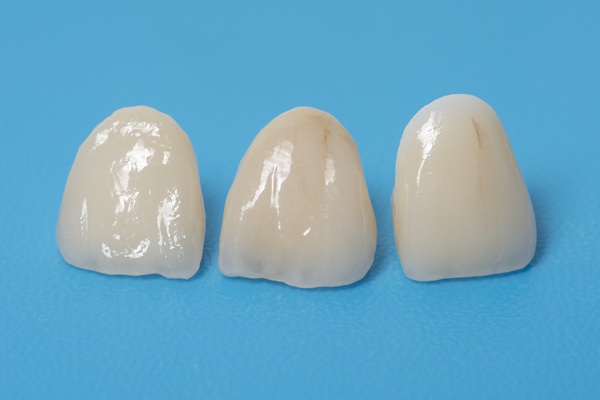Dental Crowns & BridgesMilwaukee, WI
Both crowns and bridges belong to a category called fixed prosthetic devices and are used by dentists to solve a number of cosmetic dental issues as well as issues like damaged and broken teeth. In contrast to removable devices like dentures, which you can remove easily for cleaning, crowns and bridges are fused permanently to existing teeth or implants and can only be taken out by a dental expert.
How do dental crowns work?
A crown entirely covers a damaged tooth above the gum line. Aside from increasing the resilience of the impaired tooth, crowns can also improve the shape, appearance and alignment of the tooth. Tops can be attached to the head of an implant to replace teeth functions and structure.
The dentist may suggest a crown in the following situations:
Types of dental crown materials
Dental crowns are typically manufactured from four main materials:
All ceramic (porcelain-based)
This crown material is manufactured mainly with porcelain and preferred as a restoration for damaged front teeth because the color blends well with healthy teeth. The dentist may need to scrape parts of the tooth structure to bond the porcelain crown with the tooth. Despite its aesthetic appeal and high resistance to wear, the primary concern for this kind of material is that it is somewhat fragile under heavy force.
Porcelain-infused metal crowns
This material has a metal structure but has porcelain fused to it to strengthen the teeth and ensure they are adequately sealed against leakages, reducing the chances of cavities. When the porcelain is bonded with metal, it makes the crown stronger than porcelain alone. This ensures durability and strength.
Gold alloys
This crown is made from gold, copper and other metals to develop a sturdy material that can be cemented to the tooth. Gold alloy is impervious to wear and damage and does not degrade when it grinds against other teeth. The biocompatibility of this material with the gum tissue is high.
Base metal alloys crowns
Base metal alloys crowns are made from non-noble metals that strengthen and makes the teeth highly resistant to deterioration. Base metal alloys require minimal scraping of healthy tooth structure to ensure a good fit. This crown material does not wear easily and works well with existing teeth.
How do bridges work?
Dentists usually recommend bridges if one or more teeth are missing. The space left by the lost tooth may cause the remaining teeth to turn or shift into the gap, causing a poor bite. The disruption caused by the missing teeth may eventually result in temporomandibular joint (TMJ) disorders and gum diseases.
Bridges replace the missing tooth or teeth. They cover the gap left by the lost teeth. Bridges are fused to the healthy teeth or implants near the space. The teeth-shaped materials are called abutments and function as anchors for the bridge. The substitute tooth, called a pontic, is bonded to the crowns covering the abutments.
Types of bridges
Like crowns, there are different material available for bridges. The dentist will guide your decision depending on the position of the missing tooth, aesthetic preferences, functions and pricing. Below are different kinds of dental bridges:
Traditional bridges
These are the most popular variety of dental bridges. Traditional bridges comprise of one or more pontics (false teeth), are secured firmly into position by dental crowns (abutments) and are bonded to the neighboring teeth of the lost tooth.
Cantilever bridges
These are somewhat similar to traditional bridges. However, the pontic is held in place by a crown on one side only, instead of both sides. Therefore, if one natural tooth is near the space, the bridge can still work.
Maryland bridges
These are regarded as a conservative substitute for traditional bridges. Maryland bridges comprise of a pontic held firmly in position by a metal or porcelain structure. This framework is fused to the back of the teeth on either side of the lost tooth. Since a crown is not required to hold the bridge in place, there is no need to scrape adjacent teeth.
Implant-supported bridges
These types of bridges are used when multiple teeth are missing. Rather than being supported by frameworks or crowns, they are secured in place by dental implants. Typically, one implant needs to be inserted for every missing tooth to hold the bridge. In cases where multiple implants are not possible, the bridge may use a pontic placed two implant-compatible crowns.
Making crowns and bridges
Before producing the crown or bridge, the tooth affected must be polished and filed to make the crown or bridge fit perfectly over it. After scraping the tooth, the dentist will attempt to design an impression using a proper mold of the crown or bridge that matches the shape of the tooth. If you choose porcelain, the dentist will decide the appropriate color of the crown or bridge that is similar to the color of the existing teeth.
With the impression, the dental lab will be able to make the crown or bridge according to the material specifications of the dentist. During the preparation of the permanent crown or bridge, the dentist will place a temporary replacement to cover the polished tooth. When the permanent restoration is ready, the temporary substitute will be removed, and the new crown or bridge will be bonded over the readied tooth.
What is the duration of crowns and bridges?
Although crowns and bridges have the potentials to survive lifetime use, in rare cases, they can loosen or detach. To ensure the crown or bridge lasts longer, oral health hygiene is highly significant. Bridges may fail if the tooth supporting it is affected by dental diseases.
You can keep your gums and teeth in a good state by brushing and flossing twice a daily. Also, consult your dentists and hygienist on a regular basis for dental checkups and expert teeth cleaning. To avoid damage to the new crown or bridge, try not to chew hard foods, ice or strong materials.
Dental crowns and tooth bridges give you another shot at having a normal bite and a better appearance for your teeth. By matching the color of the restoration with the existing teeth, they will look natural and improve the aesthetic appeal of your smile.
For more information or to schedule an appointment with Eastside Dental, request an appointment in our Milwaukee office here: https://www.esdmke.com/contact-us/. Or call us at (414) 888-4000 .



